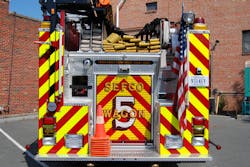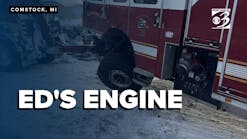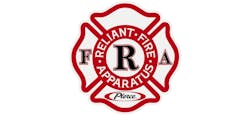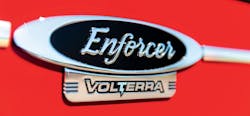The Apparatus Architect articles through the years have emphasized the importance of defining the mission of the vehicle from the outset of the specification process. While seemingly a common-sense, practical starting point for any major vehicle acquisition, there are unfortunately any number of fire-rescue departments that unknowingly add a combination of components that just don’t work well in the end, resulting in oversize and overweight in-service units.
Following are examples of issues that have developed with newly delivered and in-service apparatus that, in some cases, may not be easily solved.
CASE STUDY 1
A volunteer fire-rescue department that provided first-responder EMS service to the community determined that a smaller, four-wheel-drive unit that would encourage more drivers to become certified to operate it developed specifications with the assistance of the manufacturer for this unit. Along the way, the apparatus committee decided that in addition to the EMS capabilities, the vehicle should carry a small pump and water tank for minor incidents.
The result was the acquisition of a commercial, four-door-cab chassis with a 19,500-pound gross vehicle weight rating (GVWR) carrying a skid fire pump system with a 200-gallon water tank. The manufacturer provided some documentation with the bid proposal to show that the completed unit would have an equipment payload of 2,000 pounds. Once the unit was delivered, and as members began to conduct driver training, several members commented that the unit did not handle well and was difficult to stop. Further investigation determined that the department had added 800 pounds of equipment to the apparatus. After consultation, it was recommended that the vehicle be weighed to determine its actual in-service weight.
The results of this investigation showed that the unit was overweight on the rear axle and with just one person in the cab the unit would vastly exceed the rated 19,500-pound GVWR. After several meetings with the manufacturer and gaining advice from an apparatus architect and legal counsel, the fire department was able to have the builder take the vehicle back and refund the contract price.
CASE STUDY 2
When economic times were good, a department decided to replace two older pumpers, one with a 750-gallon tank and the other with a 1,000-gallon tank. The decision was to buy two new units, a rescue engine equipped with a 1,000-gallon tank and a sister unit with full height compartments on each side with a 1,250-gallon tank. The rationale was that since 20% of the response area was beyond hydrant protection, carrying more water on each pumper would serve the department well. Both vehicles were equipped with 31,000-pound-rated rear axles and were similarly equipped with appliances and hose loads with the rescue engine carrying hydraulic rescue tools, shoring and stabilization gear.
After several years of operation, both vehicles required extensive repairs, with one pumper experiencing ongoing electrical issues. The pumpers were over 35 feet in overall length on a 240-inch wheelbase. While they carried everything the department wanted, the result was one unit was removed from service and sold after 10 years and the other was found to be overweight on the rear axle due to the amount of equipment carried and where it was located within the body compartments.
Size considerations
While combination apparatus such as mini-pumpers, rescue engines and single-axle quints all have their place in the fire service, the design, outfitting and deployment of these units all have an impact on the department’s operational capabilities. More importantly, the safety of our personnel and impact on repair and maintenance budgets are a direct result of the size, weight and condition of our apparatus fleet.
One of the most common faults of apparatus design is to subscribe to the “incremental purchase” philosophy. For example, if a 1,250-gpm pump works, then a 2,250-gpm pump must be better. If all of your department’s engine apparatus are equipped with a 750-gallon water tank, then upsizing the tank to a 1,000 gallons may create issues that you had not considered.
While increasing the size of the water tank by 250 gallons may seem like a small amount, costing of $1,200 to $1,500, this additional size and weight can impact other areas as well. Consider that the additional tank size may also cause the body style to change with an increase in height and length. “No problem,” says the apparatus committee, yet they fail to recognize that the wheelbase just increased by 14 inches and the height of the hosebed from the ground went up another six inches.
The additional 2,085 pounds of water will probably cause an increase in the size of the rear axle, suspension, tires and wheels. If your department has performance requirements to ascend hills at a specific speed to ensure safe response times, this may also require specifying a big-block engine with higher torque ratings, which again impacts the transmission and driveline components. In the end, the seemingly insignificant cost of the additional 250 gallons now approaches over $25,000.
The initial cost of the apparatus must also consider the life cycle operational costs for the heavier vehicle, which will impact tire wear, suspension components and potential limited access to equipment stored in upper body compartments. Most importantly, properly locating fixed steps, access ladders and handrails must all be considered in the overall design of the vehicle. Simply put, what looks great on paper on the blueprint may not work out well once the completed apparatus is delivered and placed into service.
What’s to be carried
When developing specifications for any new apparatus, it is incumbent upon the fire department to develop a complete inventory of tools and equipment, including all hose loads, that will be included in the bid documents. Included with this inventory will be the anticipated weight of this equipment. This will protect the interests of the organization as your equipment inventory may weigh considerably more than the allowances provided within National Fire Protection Association (NFPA) 1901, Standard for Automotive Fire Apparatus, for the different types of apparatus. Additionally, the fire department should require a detailed weight analysis for the apparatus as proposed by each manufacturer to ensure that the unit will be built to carrying your equipment with a margin for additional equipment that may be placed onto the apparatus during its life cycle.
Overweight fire-rescue apparatus are more common than you might expect and not every story has a happy ending. Do your homework before the formal specification process starts to ensure that the new vehicle will be safe to operate and meet all of your department’s mission requirements.
TOM SHAND, a Firehouse® contributing editor, is a 37-year veteran of the fire service and works with Michael Wilbur at Emergency Vehicle Response, consulting on a variety of fire apparatus and fire department master-planning issues. MICHAEL WILBUR, a Firehouse® contributing editor, recently retired as a lieutenant in the New York City Fire Department, where he was last assigned to Ladder Company 27 in the Bronx. He has served on the FDNY Apparatus Purchasing Committee and consults on a variety of apparatus-related issues around the country. For further information, access his website at www.emergencyvehicleresponse.com.
Connect with Mike
Facebook: EVResponse
LinkedIn: michael-wilbur/8/315/b18
Twitter: EVResponse
Website: emergencyvehicleresponse.com
Connect with Tom
Facebook: tom.shand.775






